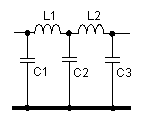
Many thanks to David Ai2A for the excellent revision of the following text
Crystals for Superhet Receivers with VXO
When building a simple superhet receiver three separate radio frequencies are encountered: the operating input radio frequency; the local oscillator frequency; and the intermediate frequency. The meaning and the related abbreviations are as follows:
When considering the final operating frequency (or an associated crystal), there is very little tolerance for error. Local laws and international treaties assign the bands and band sections in which we operate. We are not allowed to operate transmitters outside these assigned bands. The intermediate frequency choice, while still very important, is less rigid as to the exact frequency choices one makes. The "IF" frequency should be neither too high - nor too low. Several factors influence the choice of IF frequency: costs of the circuitry; selectivity, bandwidth (CW); and image frequency rejection. Typically 455 kHz to 10 MHz are the preferred intermediate frequencies for QRP devices.
Because the pulling range increases with higher fundamental frequencies, the crystal VXO frequency should be as high as possible. A typical 20 MHz crystal can be pulled up to 30 kHz (or more). The following table shows crystal combinations for QRP QRG based on cheap standard crystals. Which combination is the best has to be checked individually. The values are rounded.
VXO and IF crystals
| Band [m] | CW-QRP-QRG [kHz] | RF [kHz] | IF [kHz] | LO [kHz] |
|---|---|---|---|---|
| 160 | 1810 1843 Europe |
1806 | 4194 | 6000 |
| 1835 | 2097 | 3932 | ||
| 1843 | 3072 | 4915 | ||
| 1844 | 3276 | 5120 | ||
| 80 | 3560 | 3553 | 3000 | 6553 |
| 3567 | 4433 | 8000 | ||
| 3571 | 2982 | 6553 | ||
| 40 | 7040 7030 Europe |
7014 | 3686 | 10700 |
| 7018 | 2982 | 10000 | ||
| 7044 | 4956 | 12000 | ||
| 7059 | 4000 | 11059 | ||
| 7068 | 3932 | 11000 | ||
| 30 | 10106 (10116) | 10125 | 4194 | 14318 |
| 10085 | 4915 | 15000 | ||
| 20 | 14060 | 14059 | 3000 | 11059 |
| 14068 | 3932 | 18000 | ||
| 17 | 18080 | 18068 | 3932 | 22000 |
| 18096 | 4096 | 14000 | ||
| 15 | 21060 | 21018 | 2982 | 24000 |
| 21072 | 3072 | 18000 | ||
| 12 | 24890 | 24867 | 8867 | 16000 |
| 10 | 28060 | 28096 | 4096 | 24000 |
| 28108 | 5990 | 22118 |
From the 20 m band upwards you'll get a sufficient high LO tuning range, even if the local oscillator frequency is below the receive frequency. Another reason for the deep-set LO frequency is, that German suppliers (Reichelt, Conrad) offer fundamental crystals only up to 24 MHz. Everything above are overtone crystals, which are not well suitable for pulling due to their cut.
L and C for Amplifier Low-Pass Filters
Low pass PI network filters are universally needed when building transmitters or transceivers. E12 series capacitors are the available and are the preferred components by most builders. They do not have to be purchased specially or combined by a series or parallel configuration to achieve the needed values. Inductors are best homebrewed - not purchased. Inductors wound on toriod cores are almost always wound on a homebrew basis. .
Fig. 1: 5 element PI filter

The following low-pass filters are specified for a maximum of 5 watts output power and 50-Ohm impedance. Larger sized toroid cores are needed for the 160 m to 40 m because of the required wiring space for their higher inductance requirements.
Components data for 5 element PI filters
| Band [m] | C1, C3 [pF] | C2 [pF] | L1, L2 [uH] | Toroid | Turns |
|---|---|---|---|---|---|
| 160 | 1800 | 3300 | 6,21 | T 50-2 | 35 |
| 80 | 680 | 1500 | 3,17 | T 44-2 | 25 |
| 40 | 470 | 820 | 1,45 | T 44-2 | 17 |
| 30 | 220 | 470 | 0,98 | T 37-2 | 15 |
| 20 | 150 | 330 | 0,69 | T 37-6 | 15 |
| 17 | 120 | 270 | 0,57 | T 37-6 | 14 |
| 15 | 100 | 220 | 0,46 | T 37-6 | 12 |
| 12 |